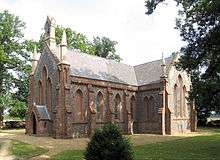John Brown (architect)
John Brown (1805–1876)[1] was a 19th-century architect working in Norwich, in the county of Norfolk, England. His buildings include churches and workhouses.
Life

All Saints, Hainford, Norfolk (1838–40).
He was the pupil of the architect William Brown of Ipswich, a close relative.[1] He was, along with his two sons, the surveyor for Norwich Cathedral, where his work there included a restoration of the crossing tower, undertaken during the 1830s.[2] He was appointed County Surveyor for Norfolk in 1835.[3]
Works
Brown's works include:[4]
- St. Peter: Lowestoft, Suffolk; built 1833; white brick with no tower, Carpenter's Gothic style; demolished circa 1974
- St. Michael's (St. Michael the Greater): Stamford, Lincolnshire; built 1835–36; Early English style; by 2002 no longer used as a church
- Sudbury workhouse: Sudbury, Suffolk; built 1836(–37?) after enactment of the Poor Law Amendment Act 1834.
- The Norwich Yarn Factory (St James Mill): Norwich; built 1836–37.
- Workhouse at Lingwood, Norfolk; built 1837. Later called "Homelea".[5] and since demolished.[6]
- Workhouse at Great Yarmouth, Norfolk; built 1838. Later the Northgate Hospital. Described by Nikolaus Pevsner as "Red brick and still classical in its proportions and its details".[7]
- All Saints, Hainford, Norfolk; 1838–40. Flint with red brick dressings; lancet windows.[8]
- Christ Church: East Greenwich in south-east London; built 1847–49; Robert Kerr, co-architect[9]
- St. Margaret: Lee, London; built 1839–41[9]
- Christchurch: New Catton, Norwich; built 1841.
- St. Mark: New Lakenham, Norwich; built 1844; modified perpendicular style.
- St. Matthew: Thorpe Hamlet, Norwich; built 1851; Neo-Norman style; Robert Kerr, co-architect; by 2002 offices.
- The Old Corn Exchange: Fakenham, Norfolk; built 1855; by 2002 a cinema.
- St Peter & St Paul Bergh Apton, Norfolk; 1838. Major internal re-ordering for Revd John Thomas Pelham.[10]
gollark: It's heavserver.
gollark: Interesting.
gollark: You realise epicbot prefixes it with "Heavpoot:"?
gollark: Heavserver.
gollark: Go <:transistorinv:736647658298540052> yourself.
References
- "Basic Biographical Details". Dictionary of Scottish Architects. Retrieved 15 September 2013.
- Pevsner 1962, p.211.
- Pevsner, Nikolaus; Wilson, Bill (2002). Norfolk 2 (2nd ed.). New Haven: Yale University Press. ISBN 9780300096576.
- List from Howard Colvin (1978). A Biographical Dictionary of British Architects 1600–1840. John Murray. p. 145. ISBN 0 7195 3328 7. except where otherwise cited.
- Pevsner 1962, p.184.
- "East Anglian Workhouses". Gressenhall Farm and Workhouse. Archived from the original on 2 January 2014. Retrieved 1 January 2014.
- Pevsner 1962, p.149.
- Pevsner 1962, p.158.
- Homan, Roger (1984). The Victorian Churches of Kent. Chichester: Phillimore & Co. Ltd. p. 106. ISBN 0-85033-466-7.
- Geoffrey Kelly, Book of Bergh Apton (Halsgrove 2005) ISBN 1-84114-418-5
Sources
Pevsner, Nikolaus (1962). North-East Norfolk and Norwich. The Buildings of England. Harmondsworth: Penguin Books.
This article is issued from Wikipedia. The text is licensed under Creative Commons - Attribution - Sharealike. Additional terms may apply for the media files.